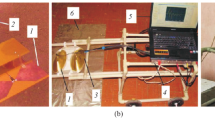Abstract
Within the ground-penetrating radar (GPR) bandwidth a subsurface materials is considered to be an ideal dielectric, which is not always the case. We have developed the dependence of the reflection coefficient of electromagnetic waves with regard to conductivity, which showed a significant effect of the difference in conductivity on the reflectivity and signal amplitude. This was confirmed by physical modeling. The electrical conductivities of a geological media should be taken into account when solving direct and inverse problems, survey design planning, etc. Ground-penetrating radar can be used to solve the problem of mapping of the halocline or to determine water contamination.
Similar content being viewed by others
References
Annan, A.P., Ground Penetrating Radar Workshop Notes, Ontario: Sensors & Software Inc., 2001.
Debai, P., Izbrannye trudy. Stat’i 1909–1965 (Collected Papers. Articles for 1909–1965), Dzyalo, I.E. and Gurevich, V.L., Eds., Leningrad: Nauka, 1987.
Ellison, W.J., English, S.J., et al., A comparison of ocean emissivity models using AMSU, the SSM/I, the TRMM Microwave Imager, and airborne radiometers observations, J. Geophys. Res., 2003, vol. 108, no. D21, p. 4663.
Gadani, D.H., Rana, V.A., and Bhatnagar, S.P., Effect of salinity on the dielectric properties of water, Indian J. Pure Appl. Phys., 2012, vol. 50, pp. 405–410.
Ground Penetrating Radar Theory and Applications, Jol, H.M., Ed., London: Elsevier, 2009.
Krylov, S.S., Bobrov, N.Yu., and Kiselev, E.Yu., Georadiolocation studies of halocline, Proc. 4th EAGE Int. Sci. Pract. Conf. and Exhibition on Engineering and Mining Geophysics, Gelendzhik, 25 aprelya, 2008, 2008. http://www.earthdoc.org/publication/publicationdetails/?publication=46319.
Meissner, Th. and Wentz, F.J., The complex dielectric constant of pure and sea water from microwave satellite observations, IEEE Trans. Geosci. Remote Sensing, 2004, vol. 42, no. 9, pp. 1836–1849.
Parsell, E., Berkeley Physics Course. Vol. 2. Electricity and Magnetism, Education Development Center, 1965.
Sadovskii, I.N., Analiz modelei dielektricheskoi pronitsaemosti vodnoi sredy, ispol’zuemykh v zadachakh distantsionnogo zondirovaniya akvatorii (Analysis of Models of the Dielectric Permitivity of the Water Environment Used in Problems of Remote Sensing of Water Areas), Moscow: FGBUN IKI RAN, 2013.
Somaraju, R. and Trumpf, J., Frequency, temperature and salinity variation of the permittivity of seawater, IEEE Trans. Antennas and Propagation, 2006, vol. 54, no. 11, pp. 3441–3448.
Starovoitov, A.V., Interpretatsiya georadiolokatsionnykh dannykh (Interpretation of Georadiolocation Data), Moscow: Mosk. Gos. Univ., 2008.
Stogryn, A., Equations for calculating the dielectric constant for saline water, IEEE Trans. Microwave Theory and Techniques, 1971, vol. 19, no. 8, pp. 733–736.
Stogryn, A.P., Bull, H.T., Rubayi, K., and Iravanchy, S., The Microwave Dielectric Properties of Sea and Fresh Water, California, Azusa, GenCorp Aerojet, 1995.
Sudakova, M.S., Development and application of the method of dielectric measurements using field georadar in laboratory conditions, Extended Abstract of Cand. Sci. (Geol.-Mineral.) Dissertation, Moscow: Mosk. Gos. Univ., 2009.
Vladov, M.L. and Pyatilova, A.M., Estimation of environment absorbing properties in laboratory ground penetrating radar researches, Russ. Geophys. J., 2015, no. 6, pp. 55–61.
Vladov, M.L. and Sudakova, M.S., Georadiolokatsiya: ot fizicheskikh osnov do perspektivnykh napravlenii (Ground Penetrating Radar. From physical Bases to Future Trends), Moscow: Geos, 2017.
Author information
Authors and Affiliations
Corresponding author
Additional information
Original Russian Text © M.S. Sudakova, M.L. Vladov, M.R. Sadurtdinov, 2018, published in Vestnik Moskovskogo Universiteta, Seriya 4: Geologiya, 2018, No. 1, pp. 100–106.
About this article
Cite this article
Sudakova, M.S., Vladov, M.L. & Sadurtdinov, M.R. The Influence of Conductivity on the Reflected Ground Penetrating Radar SIgnal Amplitude. Moscow Univ. Geol. Bull. 73, 206–212 (2018). https://doi.org/10.3103/S0145875218020102
Received:
Published:
Issue Date:
DOI: https://doi.org/10.3103/S0145875218020102




